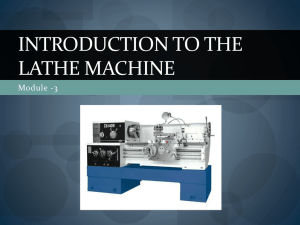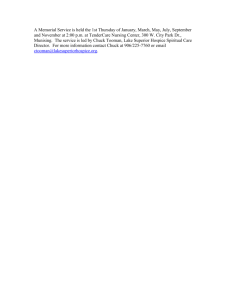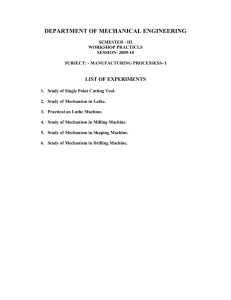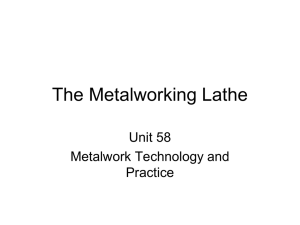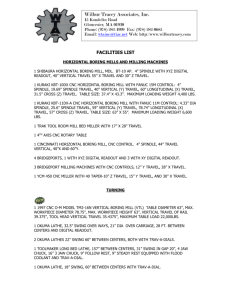Lathe Parts
advertisement
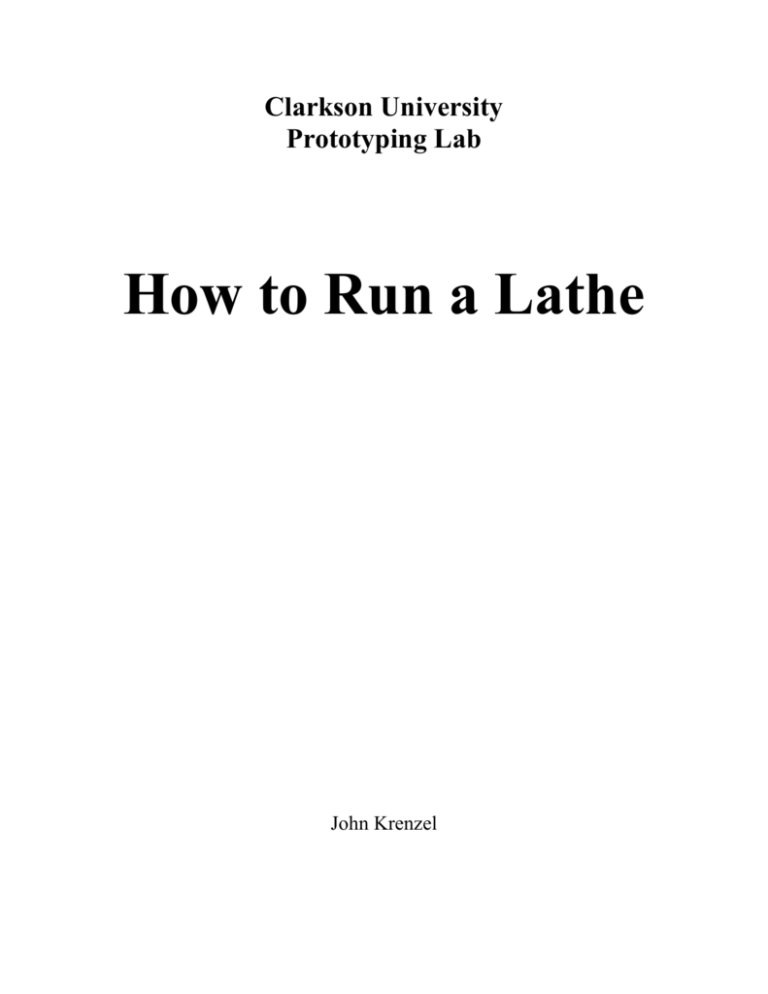
Clarkson University Prototyping Lab How to Run a Lathe John Krenzel This guide is designed to provide a basic overview of lathe operation and familiarize the student with general terms associated with a lathe. A lathe has many uses in a machine shop—far too many to be thoroughly detailed in an introductory guide such as this. A more detailed and advanced version of the information contained in this guide may be found in the South Bend Lathe Work’s “How to Run A Lathe” instructional manual, available in the Clarkson machine shop. Contents Cutting Tools – Grinding a Cutting Tool, Tool Applications Page 3-4 Lathe Parts 5-6 Lathe Operation - Chuck Speeds, Carriage and Power Feed Operation 6-8 Machine Set-up – Cutting Tool and Toolpost Position, Chucks 9-11 Basic Machining Operations – Facing, Drilling, Turning, Boring 11-14 Notes – Determining Lathe Type 15 Certification Program 16 Basic Machining Operations Course 17 2 Cutting Tools In order to machine metal accurately and efficiently, it is necessary to learn how to create the correct type of cutting tool for the kind of material being machined and set it at the correct height in the machine. For the lathes in this shop we will be using cutting tools made of high speed steel (HSS). Grinding a cutting tool When grinding a new tool for turning and facing, we start with a tool blank. Using a pedestal grinder the blank is gradually ground away until the general shape shown below is obtained. There are example tool bits located near the grinder, made of wood and exaggerated in size, to aid in this process. When grinding, the blank should be held securely and pressed firmly against the grinding wheel. The side of the palm should rest on the hand-rest located in front of the wheel. The proper procedure is usually learned with plenty of practice. After the shape is obtained, the cutting edge of the tool should be honed with a small diamond hone. This will lengthen the life of the tool and make it cut much better, especially for finishing cuts. This tool is useful for most steels and aluminum. Other materials, such as copper, bronze, cast iron, wood and plastics, require slightly different style tools. The book “How to Run a Lathe” contains a description of these, as well as tools for other applications, such as boring, threading, parting and knurling. 3 4 Lathe Parts This section is designed to familiarize the student with the parts and purpose of the various control levers and knobs found on a lathe. The principal parts of the machine are shown below, followed by a short description of each. Back gears – when engaged, allow slow chuck speeds. Back gear lever – engages/disengages back gears. Bed – supports and aligns the headstock, carriage, and tailstock. Bull gear lock pin – engages/disengages the chuck to the back gears. Carriage – supports the cutting tool, moves the tool along the bed and houses the tool feed mechanisms. Chuck – holds and automatically centers the workpiece. Cross-slide – feeds the cutting tool into and away from the center-line of the machine, used for facing. Compound rest – used in thread cutting and turning tapers. Drive belt – connects the motor to the headstock pulley. Drive belt tension release – releases tension on drive belt, allowing chuck speed changes. Gear box – controls the cutting tool feed rate. Headstock – supports the chuck and houses the drive belt. 5 Live center - used to support the end of a long workpiece. Motor – located inside the machine leg. Pulley – used to change chuck speeds. Tailstock – used to support the live center and hold the tailstock chuck. Tailstock chuck – drill chuck that can be inserted into the tailstock for drilling. Lathe Operation This section is designed to familiarize the student with the operation of the various control levers and knobs found on a lathe, as well as selecting the spindle speeds and cutting tool feed rates. Chuck Speeds The spindle speed on the South Bend lathe is changed by shifting the drive belt from one step of the pulley to another and by engaging or disengaging the back gears. The various speeds for this machine are as follows: Approximate Spindle Speeds Configuration Direct Back Gear Small 740 130 Pulley Medium 470 85 Large 304 55 6 Direct belt drive – To arrange the lathe for direct belt drive (the high range of speeds), push the back gear lever back as far as it will go; then pull out and up on the bull gear lock pin and revolve the pulley by hand until the lock pin slides into position and locks the pulley to the chuck. Back geared drive – To engage the back gears (the slow range of speeds), pull the bull gear lock pin out and push it down to disconnect the pulley from the chuck, and pull the back gear lever forward. Rotate the pulley by hand to ensure the back gears are engaged properly. Never engage the back gears while the machine is running! Carriage Operation The operating parts of the carriage are shown below. Handwheel – the handwheel is turned to advance the carriage along the lathe bed. Cross feed knob - feeds the cutting tool into and away from the center-line of the machine. Compound rest knob - feeds the cutting tool into and away from the center-line of the machine, is used primarily for thread cutting and turning tapers. Carriage lock screw – locks the carriage to the lathe bed. This screw should never be tightened except for facing and cutting off operations. 7 Power Carriage Feed Operation This lathe is equipped with a power carriage feed which either feeds the carriage longitudinally along the bed or the cross slide across the bed. To obtain the desired feed rate it is only necessary to arrange the levers on the gear box according to the index chart located on top (also shown below). The smaller figures on the chart indicate the longitudinal feed per revolution in thousandths of an inch. The larger numbers are used in thread cutting and represent the number of threads per inch. The lever on the left should be placed in the letter position corresponding to the desired feed rate from the index chart. The lever on the right should be placed directly under the desired feed rate on the index chart. Feed reverse lever – located on the left end of the headstock, this lever reverses the direction of the carriage feed. The lever is squeezed and moved up or down to change the feed direction. Never attempt to reverse the feed direction while the machine is running! Feed clutch lever - the power feed on this machine is engaged by lifting up on this lever. Feed change lever - this lever changes the feed between the carriage (used for turning) and the cross slide (used for facing). Half nut lever – this lever is only used in thread cutting. 8 Machine Set-up Setting up a cutting tool The cutting tool needs to be set up in the machine in the correct manner in order to cut properly. For most turning and facing, the tip of the cutting edge should be aligned on center or slightly above, as shown below. This can be done using the live center, mounted in the tailstock. The toolbit is placed in the toolholder, tightened, and placed on the toolpost. The toolpost is then rotated toward the live center. Compare the tip of the tool with the tip of the live center. Adjustments should be made with the adjusting nut until the two are aligned. The toolpost is then rotated to the desired position for turning or facing. This alignment should be checked each time a tool is inserted into the toolholder. Toolpost position The toolpost position is dictated by the type of machining being done. The pictures below show the proper position for various operations. 9 Chucks Work is typically held in a chuck for machining. Several different types are used, mainly the 3-jaw universal, 4-jaw independent and the draw-in collet chuck. The 3-jaw universal chuck is used for holding round and hexagonal work. The three jaws move simultaneously and automatically center the work. The jaws can be removed and reversed for holding work externally or internally. The 4-jaw independent chuck has four reversible jaws, each of which may be independently adjusted. This chuck is used to hold square, round and irregular shapes in either concentric or eccentric positions. The jaws can be removed and reversed for holding work externally or internally. Since the work is not automatically centered, the use of a dial indicator is necessary. The draw-in collet chuck is the most accurate of all chucks, and is used for precision work. Collets are made for round and square shapes and the size of the work held in the collet should not be more or less than .001 in. of the size indicated on the end. Removing and installing the various types of chucks should be done only with supervision of the shop monitor until students become familiar with the procedure. 10 Holding the work How the work is held depends on the work itself. Work that does not extend far from the chuck can be held using only the chuck. For work that is thin or extends far out from the chuck, the end opposite the chuck will need to be supported by the live center. This is done by center-drilling (described below) the work and using a live center in the tailstock. The tailstock is locked to the bed and the tailstock handwheel is advanced to bring the live center into contact with the work. A small amount of pressure is applied and the handwheel locked. This will provide the necessary support to prevent the work from deflecting away from the cutting tool. Basic Machining Operations This section describes the basic material-removing operations of the lathe. Facing Facing removes material from the ends of the work. Before turning the diameter of a shaft, the ends should be faced square. This is done as follows: 1. Set the machine up as described above in the Toolpost Position section. 2. Set the cutting edge of the tool exactly on center as described above in the Setting up a cutting tool section. 3. If using the power feed, adjust the feed change lever and the feed reverse lever to allow the carriage cross slide to move in the desired direction (usually from the center of the work toward the operator). 4. Set the desired feed rate as described in the Power carriage feed section. 5. The tool should slowly be brought close to the work until it lightly touches the face end of the work. The handwheel should then be fed in the desired distance. 6. Feed the cross slide knob out to face the end. 11 Drilling One of the most common uses for a lathe, drilling, is used to remove material from the center of the work. Any time a hole is to be drilled, the work must first be center-drilled. This prevents the drill itself from “walking” off center. A center-drilled workpiece end also provides an accurate placement for a live-center. Center-drilling is as follows: 1. Face-off the end of the work. This provides a flat surface to center-drill into. 2. Insert a drill chuck into the tailstock and mount a center-drill in it. Note: to remove a live center or drill chuck from the tailstock it is necessary to turn the handwheel counterclockwise until the center or chuck comes loose. 3. The tailstock is brought within an inch of the work. Lock the tailstock to the bed. 4. Gradually feed the center-drill into the work using the tailstock handwheel. 5. The center-drill should be fed into the work until it covers approximately three-quarters of the large tapered part of the drill. Do not drill any deeper. 12 To drill a hole: 1. Unlock the tailstock and slide it away from the work. Remove the center drill and replace with the desired drill size. 2. Bring the tailstock to within an inch of the work and lock the tailstock to the bed. 3. Gradually feed the drill into the work, using the handwheel, to the desired depth. 4. For deep holes, the drill will need to be repeatedly inserted and removed to clear chips and keep cutting oil on the drill tip. 5. For large diameter holes, a smaller pilot hole will need to be drilled first to allow clearance for the large drill’s web and to keep it centered throughout the work. Turning Turning is used to remove material from the diameter of the work. To turn a workpiece the following procedure should be followed: 1. Set the lathe toolpost as described above in the Toolpost Position section according to the type of turning desired. 2. Follow the guidelines above for setting the tool on center in the Setting up a cutting tool section. 3. Adjust the feed change lever and the feed reverse lever to allow the carriage to move in the desired direction (usually toward the chuck). 4. Set the desired feed rate as described in the Power carriage feed section. 5. The tool should slowly be brought close to the work until it lightly touches the diameter of the work. The carriage is then backed away slightly and the cross slide knob is fed in the desired distance. 6. Engage the power feed with the feed clutch lever. 13 Boring Boring is used to increase the diameter of a previously drilled hole. It is necessary when the desired diameter is larger than available drill bits, or fine finishes are required. Most boring bars extend out far from the toolpost to allow for deep holes. This causes the boring bar to flex under heavy cuts. Therefore, the boring bar should be only used for small cuts or as a finishing tool. The majority of the material should be removed using a standard drill bit. 1. A hole should be drilled to 8090% of the required hole diameter. 2. The boring bar is set up in the machine and the tool is set on center, as described above. 3. Set the carriage feed direction and feed rate in the same manner as turning. 4. The tool should slowly be brought close to the work until it lightly touches the inside diameter of the work. The carriage is then backed away slightly and the cross slide knob is fed out the desired distance. 5. Engage the power feed. It is important to realize that the cross slide knob will be used in a manner opposite of turning. The direction of decreasing numbers on the cross slide knob is the direction of increasing hole diameter. 14 Notes Determining the “type” of lathe The lathes in the Clarkson machine shop are of two types, “radius” and “diameter”. This designation refers to the reading given by the cross feed knob. The graduations (distance between each mark on the dial) on all the lathes are thousandths of an inch (.001 in.). Each lathe manufacturer decides whether the graduation means onethousandth of the diameter or one-thousandth of the radius. This is very important information to know, especially during a finishing cut, and it’s easy to check. To find out which one you have: Take a small cut just far enough to allow room to measure the diameter. Make a measurement and remember it. Turn the cross feed knob in a small amount, say ten-thousandths (.010 in.). Take another cut. Make another measurement. The difference between the first measurement and the second will either be .010” or .020”. If it’s .010” you have a diameter lathe. If it’s .020 you have a radius lathe. Now you can see that this is good to know for a final finishing cut. It’s the difference between the right size part and scrap. 15 Clarkson University Prototyping Lab – Small Lathe Certification Program Clarkson University requires that all students working in the machine shop area pass through a safety and machine skills training program. To qualify for small lathe training program, students must first have completed, and be certified in, the basic shop safety and drills and saws training programs. The following is a list of skills the small lathe student must accomplish in order to become certified. Student name: _____ 1. Lathe tool grinding Carbon steel practice tool High Speed Steel tool _____ 2. Lathe Parts and Operation Lathe Parts Chuck Speeds Carriage Operation Power Carriage Feed and Operation _____ 3. Machine Set-up Setting up a cutting tool Toolpost position Chucks Holding the work _____ 4. Basic machining operations (following page) Aluminum Steel 16 Basic Machining Operations Course Aluminum Facing – Face off the work. Turning – Turn back 2 in. of length. Determine the heaviest cut that can be taken. Determine if the lathe is a “radius” or “diameter” lathe. Remove the tool, sharpen and hone. Determine the lightest cut that can be taken. Turn to 1.500 in. diameter. Drilling – Center drill. Drill .375 in. diameter pilot hole 2 in. deep. Drill .625 in. diameter hole 2 in. deep. Boring – Bore .625 in. drilled hole to .750 in. diameter, 2 in. deep. Low carbon steel Facing – Face off the work. Turning – Turn back 2 in. of length. Determine the heaviest cut that can be taken. Remove the tool, sharpen and hone. Determine the lightest cut that can be taken. Turn to .750 in. diameter. Drilling – Center drill. Drill .375 in. diameter hole 2 in. deep. 17
